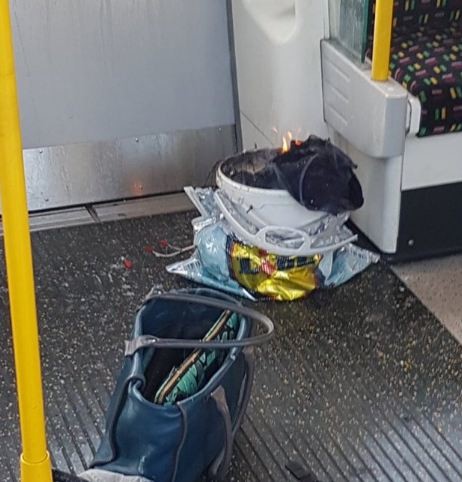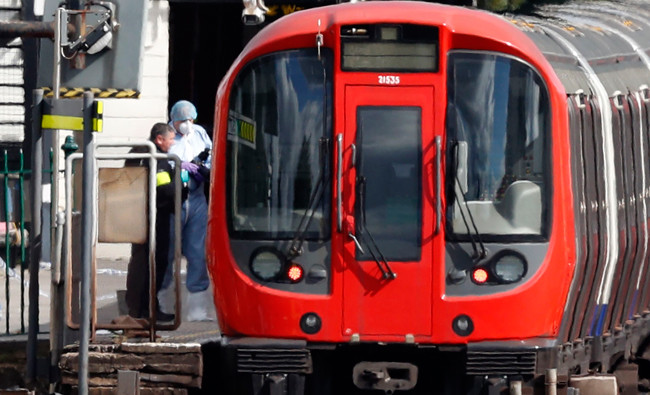LONDON: British police said an IED was used in the attack on a London Underground station which injured 22 people in what officers described as a “terrorist incident.”
“We now assess that this was a detonation of an improvised explosive device,” Britain’s top counter-terrorism officer Mark Rowley said on Friday.
London’s police are being supported by Britain’s MI5 intelligence service, he said.
British Prime Minister Theresa May has returned from her constituency to chair an emergency session of the Cobra committee, where she is being briefed on the full details of today's incident.
This will be her first opportunity to receive a full update on the live investigation underway and discuss any precautionary measures that need to be taken in the wake of the attack before making a statement to the British public this afternoon.
According to reports from Sky News, citing security sources, British security services have already identified a suspect involved in the attack, with the help of surveillance footage.
“Security sources say they’ve identified a suspect involved in the Parsons Green bombing, with the aid of CCTV footage,” Mark White, a home affairs correspondent for Sky News, said on Twitter.
The current threat level in the UK from international terrorism is “severe” according to the MI5 website.
But the BBC’s Frank Gardner tweeted that if the UK Joint Terrorism Analysis Centre concludes there is a bomber on the loose the national threat level would likely be raised to “critical.”
Police earlier said they believed someone who was not on the train at the time triggered the device with a timer.
Rowley said there would be an enhanced police presence on public transport services in London and asked the public to “remain vigilant but not be alarmed.”
He did not reveal whether any arrests have yet been made. Met police sources have revealed that the device used did not detonate fully.
Witness accounts
Earlier witnesses described the scene, saying that commuters fled the area after the blast sent a “fireball” through the station in West London, leaving several injured and sparking panic.
Eye witnesses spoke of people being trampled as panicked passengers ran for the same door.
Some passengers appeared to have suffered facial burns.
One man said he heard a “whoosh” sound and saw the next carriage “engulfed in flames.”
An eyewitness on the train at the time of the explosion told Sky News there were “hundreds and hundreds of people running down a tiny staircase,” and described “blood curdling screaming.”
Ben Geoghegan, a Parsons Green resident who has been evacuated from his home, said “There was panic all over the place. People didn’t know what to do.”
London’s Mayor Sadiq Khan confirmed on Twitter that he was in touch with the emergency services and advised people to check the Metropolitan Police Twitter account for updates and advice.
I'm in contact with @metpoliceuk and emergency services about the incident at Parsons Green. Follow @metpoliceuk for updates & advice.
— Mayor of London (@MayorofLondon) September 15, 2017
In a statement released on his Twitter account Khan said: “Our city utterly condemns the hideous individuals who attempt to use terror to harm us and destroy our way of life… As London has proven again and again, we will never be intimidated or defeated by terrorism.”
He said he was in “close contact” with the Metropolitan Police, Transport for London (TfL), Government and other emergency services.
And he said he would be attending the “emergency COBRA meeting in Whitehall this afternoon with the Prime Minister.”
“My sincere gratitude goes to all our courageous emergency responders and the TfL staff who were first on the scene… I urge all Londoners to remain calm and vigilant, and to check TfL’s website for travel advice.”
Images apparently from the scene appear to show a charred white bucket inside a carrier bag on the train, although damage to the carriage does not appear to be extensive.
The device
BBC Security Correspondent Frank Gardner described the device as “relatively small and relatively amateur,” adding that he believed the attacker probably intended to inflict a lot more casualties.
And a former Ministry of Defence counter-terrorism expert said the image “doesn’t look like a high-end explosive from IS,” using an alternative name for Daesh.
Work colleague was on district line train at Parsons Green when bag exploded #london pic.twitter.com/1yXOsFVAJ1
— Andy Webb (@andyjohnw) September 15, 2017
This tweet appears to show the burning remains of the suspect package.
Video of bucket on fire Parsons Green pic.twitter.com/K4ZFk0TZm5
— craig ursell (@craigeee1) September 15, 2017
Emergency services were called to the scene at 8:20 a.m. after reports of an explosion on the District Line train.
London Fire Brigade confirmed that it had a number of appliances at the scene, as well as approximately 50 firefighters.
London Ambulance said paramedics were present.
In a statement London Ambulance Service said: “Our initial priority is to assess the level and nature of injuries.”
Images posted on Twitter showed a women being attended to by emergency services sitting on a pavement.
Police said they were aware of reports on social media and would release facts regarding the incident once they could be sure of their accuracy.
Trump tweets "unhelpful"
Transport for London said on Twitter that there was no service between Earls Court and Wimbledon on the District Line which runs through Parsons Green.
An official source at the Saudi Arabia’s Ministry of Foreign Affairs expressed the Kingdom’s “strong condemnation and denunciation” of the attack.
The source added that the Kingdom maintained its solidarity with the UK and its stand against terrorism and extremism.
President Donald Trump took to Twitter later to blast the “loser terrorists” behind the attack.
“Another attack in London by a loser terrorist,” he tweeted.
“These are sick and demented people who were in the sights of Scotland Yard. Must be proactive!” he added in what appeared to be criticism of how the British police are handling terrorism on its shores
Another attack in London by a loser terrorist.These are sick and demented people who were in the sights of Scotland Yard. Must be proactive!
— Donald J. Trump (@realDonaldTrump) September 15, 2017
He then added: “Loser terrorists must be dealt with in a much tougher manner,” without giving details of what that meant.
“The internet is their main recruitment tool which we must cut off & use better!” he added, also giving no details.
Loser terrorists must be dealt with in a much tougher manner.The internet is their main recruitment tool which we must cut off & use better!
— Donald J. Trump (@realDonaldTrump) September 15, 2017
It was not immediately clear if the people behind the bomb attack on Friday were indeed previously known to British law enforcement.
But if it were the case, then Trump has apparently revealed the detail before authorities in Britain made the information public themselves.
Trump’s comment was described as “unhelpful speculation” by London’s Metropolitan Police.
Nick Timothy, former chief of staff to British Prime Minister Theresa May also branded the US leader’s tweet “unhelpful.”
“True or not – and I’m sure he doesn’t know – this is so unhelpful from leader of our ally and intelligence partner,” he wrote on Twitter.
Community spirit
Meanwhile in typical British tea-loving form, local residents have been tweeting offers to “put the kettle on” for those caught up in the incident.
If anyone is feeling shocked or confused at #ParsonsGreen, I'm round the corner and the kettle's on
— Katy Dunn (@katysdunn) September 15, 2017
Anyone who's now stuck in Parsons Green/Fulham drop me a line and I'll get the kettle on! #ParsonsGreen
— James Edge (@360Edgee) September 15, 2017
London’s latest attack happened around the same time as a knife-wielding man attacked a soldier in Paris, although no one has yet suggested that the attacks were coordinated.
The soldier, who was part of an anti-terrorism operation known as Sentinelle, rapidly tackled the man and was uninjured. The attacker was taken into custody.
(Additional reporting by news wires)































